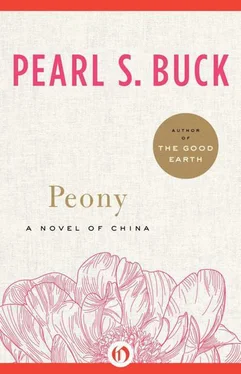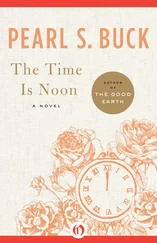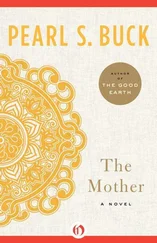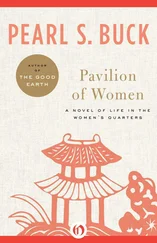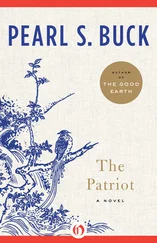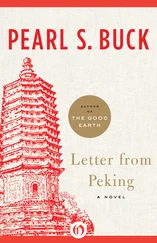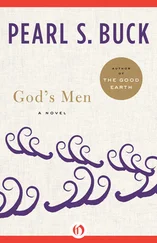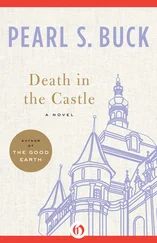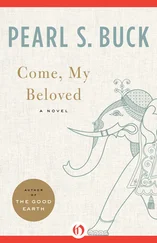Pearl Buck - Peony
Здесь есть возможность читать онлайн «Pearl Buck - Peony» весь текст электронной книги совершенно бесплатно (целиком полную версию без сокращений). В некоторых случаях можно слушать аудио, скачать через торрент в формате fb2 и присутствует краткое содержание. Год выпуска: 2012, Издательство: Open Road Media, Жанр: Современная проза, на английском языке. Описание произведения, (предисловие) а так же отзывы посетителей доступны на портале библиотеки ЛибКат.
- Название:Peony
- Автор:
- Издательство:Open Road Media
- Жанр:
- Год:2012
- ISBN:нет данных
- Рейтинг книги:3 / 5. Голосов: 1
-
Избранное:Добавить в избранное
- Отзывы:
-
Ваша оценка:
- 60
- 1
- 2
- 3
- 4
- 5
Peony: краткое содержание, описание и аннотация
Предлагаем к чтению аннотацию, описание, краткое содержание или предисловие (зависит от того, что написал сам автор книги «Peony»). Если вы не нашли необходимую информацию о книге — напишите в комментариях, мы постараемся отыскать её.
Peony — читать онлайн бесплатно полную книгу (весь текст) целиком
Ниже представлен текст книги, разбитый по страницам. Система сохранения места последней прочитанной страницы, позволяет с удобством читать онлайн бесплатно книгу «Peony», без необходимости каждый раз заново искать на чём Вы остановились. Поставьте закладку, и сможете в любой момент перейти на страницу, на которой закончили чтение.
Интервал:
Закладка:
For their part, the native Chinese left negligible information about the foreigners in their midst. Only six references to Jews have ever been found in official government documents, all dating to the Yuan dynasty. Extensive contact with foreign peoples and cultures was one of the unique features of the Yuan dynasty, during which time commerce flourished. It is therefore not surprising that the only bits of information on the Jews found in official Chinese government sources should appear during this dynasty. Mentioning Jews in the same breath as the Moslems, the Statutes of the Yuan Dynasty decreed a prohibition on ritual slaughter on January 27, 1280. Forty years later the same Statutes mention Jews, Moslems and Nestorians with regard to the payment of taxes. The Official History of the Yuan Dynasty contains the remaining instances in which Jews are mentioned, for the years 1329, 1340 and 1354. Jews were prohibited from tax exemption and the ancient practice of having a widow marry her deceased husband’s brother — a practice common to both Moslems and Jews.
Local gazetteers dating to the 17th century indicate that a great number of Chinese Jews attained high rank in the civil service system. While the gazetteers attest to the great success the Jews had in Chinese society by virtue of their disproportionate numbers having passed this difficult exam, they also serve as the first indication in Chinese sources of the tremendous degree of assimilation which must have taken place in advance of the Jews’ ability to master the Confucian Classics by then, for the Classics were essential for any hope of passing the exams and attaining high rank in society.
History Etched in Stone
The bulk of our knowledge of early Jewish life in Kaifeng comes not from the Arabs and not from the Europeans or the native Chinese, but rather from the Jews themselves, in the form of inscriptions found on steles (stone monuments) which they erected in the synagogue’s courtyard as early as 1489.
The steles offer a fascinating glimpse into the way the Jews portrayed their history and customs, both to themselves and to their Chinese neighbors. Dated 1489, 1512, 1663 and 1669, two of these stone monuments are all that is left of this exotic community today in Kaifeng.
The 1489 stele was erected in commemoration of the rebuilding of the synagogue, which had been destroyed in a flood during 1461. It speaks of the Emperor granting express permission to the Jews to build their first synagogue on that very spot in the year 1163. Chronicling the history of the Jewish religion, it mentions at the outset that the patriarch Abraham was the nineteenth generation descendant of “Pangu-Adam.” That the stele was erected at all shows the point at which the Jews can be said to have truly assimilated into their environment, since it was a Chinese, rather than a Jewish, custom to do so in houses of worship. And that the first man in Biblical creation could be combined in one breath with the first person in the Chinese story of creation is further testimony to the degree of assimilation the Jews felt with their Chinese neighbors by the 15th century.
From the 1489 stele we learn that the Jews made no images, fasted four times per month, and observed Jewish laws and rituals — in a language filled with Biblical wisdom, yet interspersed with sayings from the Analects of Confucius! Moses and Ezra are mentioned early on in the stele as well, and seem to take on the qualities of Confucian gentlemen rather than those of wandering Israelites. The Jewish religion, so it goes, came from India. Originally, seventy or more clans came to Kaifeng, where the Emperor of the Song dynasty said to them: “You have come to Our China; reverence and preserve the customs of your ancestors, and hand them down at Bianliang (Kaifeng).”
It is generally believed that 17, rather than 70, was the number of clans meant to have come, since the pronunciation for “70” and “17” in Chinese is so similar that mistakes could have been easily made. Of those clans, only seven particular surnames have remained and are to this day indicative of Jewish origin: Ai, Gao (Kao), Jin (Chin), Li, Shi, Zhang (Chang) and Zhao (Chao).
It is also clear that the Jewish community of Ningbo donated a Torah scroll to the Kaifeng community after the devastating flood of 1461. The contributions of individual members to the reconstruction of the synagogue, and the high civil service ranks attained by others, was duly noted, as was the fact that Judaism was in no way in conflict with the other great religions prevalent in China — Buddhism, Daoism and Confucianism. In fact, it went out of its way to explain that the Jews were not only loyal to their G-d, who must have seemed so foreign to the Chinese, but also quite loyal to the Emperor. In contrast to this, however, is the fact that above the Imperial Tablet, which was placed in all authorized temples symbolizing the protection and authority of the State (and proclaiming “Long live the great Emperor!”), the Jews placed a Hebrew inscription in beautiful gold letters, which only they could read. It was the Shema, the Hebrew article of faith, proving that although they were respectful of the government, G-d alone was higher than the Emperor.
The second inscription, dating to 1512, was actually carved on the reverse side of the 1489 stele and further details the Jewish religion, taking great pains to note the many similarities between Judaism and Confucianism. In particular, the notion of zedakah, or charity, is explored in detail. “A Record of the Synagogue Which Respects the Scriptures of the Way,” this stele claims the Jews entered China as early as the Han dynasty (206 B.C.E.-22 °C.E.), but offers little new information about Judaism that was not already described on the first stele. Once again, Jews from other communities (this time a Mr. Jin of Yangzhou, who donated a Torah and set up the second archway to the synagogue) are noted for their donations and efforts on behalf of Kaifeng’s Jewish community.
Although the 1663 stele is now lost, rubbings of it still remain. Commemorating the second rebuilding of the synagogue, which had again been destroyed in a flood by the Yellow River in 1642, this stele was most likely not written by Jews at all. In it, Adam is described as the nineteenth generation descendant of Pangu, and the Jews were said to have entered China during the Zhou dynasty (1100-221 B.C.E.), an even more fantastic claim than that on the 1512 stele. The 1663 stele is replete with quotations from the Chinese Classics — all of which signifies an even greater desire to appear Sinified.
Lastly, there was a stele erected in 1679 by the Zhao clan, commemorating the setting up of the Zhao Family Memorial Archway and enumerating the many contributions this family made to the Jewish community throughout the years. It was discovered built into the wall of a house occupied by a Zhao family, on the southern perimeter of the synagogue enclosure. In fact, this area is where many members of the Zhao clan can still be found today.
That Pearl S. Buck made a point of mentioning the Ezra family was of the Zhao clan is worth noting here, since the Zhao’s have represented the most prominent members of the Kaifeng Jewish community over the centuries. Local gazetteers give us the most information about the Zhao clan, due to their extraordinary success in the civil service exam, and hence, in Chinese society. One Zhao family is the direct descendant of the man who built Kaifeng’s first synagogue in 1163. And in 1421, it was Zhao Cheng who was responsible for the reconstruction of the synagogue. Two Zhao brothers and other leaders of the community are credited with having saved several Torah scrolls after the 1642 flood. In 1653 they actively helped rebuild the synagogue and restore the manuscripts. In the 19th century, two of their members were invited to go to Shanghai to relearn Hebrew and Judaism, as shall be seen shortly. The Zhao’s remain the spokesmen for the history of the Jews in Kaifeng into the 20th century.
Читать дальшеИнтервал:
Закладка:
Похожие книги на «Peony»
Представляем Вашему вниманию похожие книги на «Peony» списком для выбора. Мы отобрали схожую по названию и смыслу литературу в надежде предоставить читателям больше вариантов отыскать новые, интересные, ещё непрочитанные произведения.
Обсуждение, отзывы о книге «Peony» и просто собственные мнения читателей. Оставьте ваши комментарии, напишите, что Вы думаете о произведении, его смысле или главных героях. Укажите что конкретно понравилось, а что нет, и почему Вы так считаете.
